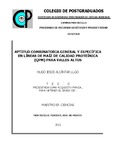| dc.description.abstract | El objetivo de este trabajo fue identificar líneas de maíz de alta ACG y cruzas de alta ACE proclives a ser utilizadas como progenitores de híbridos o variedades sintéticas de calidad proteínica para Valles Altos; así como evaluar el efecto que tienen prácticas como el desespigado del progenitor hembra y permitan la optimización en la producción de semilla mejorada. El estudio se realizó en la FESC-UNAM y en el CEVAMEX-INIFAP, en el Estado de México, durante el ciclo P-V 2014, se evaluaron 36 genotipos resultantes de las cruzas de seis líneas de maíz QPM bajo un diseño de apareamiento dialélico 6x6 mediante el Método I de Griffing. En el primer ensayo se evaluó el efecto del desepigue en el rendimiento del grano, comparando plantas a las cuales se les removió la espiga manualmente antes de la antesis contra plantas sin remoción. En el segundo ensayo se estimaron los efectos de ACG de seis líneas y la AGE, efectos recíprocos de las cruzas directas y reciprocas para las variables rendimiento de grano y sus componentes, la altura de planta y mazorca, floraciones, peso en campo, número de mazorcas buenas, malas y totales; se calificó sanidad de planta, de mazorca y la cobertura; se construyó la estructura genética de las genotipos para poder identificar el valor de efectos aditivos y dominancia dentro de estas. Finalmente en el tercer ensayo se estimaron los efectos de ACG, ACE y efectos recíprocos en variables de calidad de grano como él % de proteína, lisina y triptófano así como el índice de calidad, índice de flotación, peso de cien granos y el rendimiento identificando los mejores genotipos. El diseño de experimental consistió en bloques completos al azar y el análisis estadístico de los datos fue factorial, considerando como fuentes de variación: localidad, genotipo, tratamientos (cuando existieron), ACG, ACE, recíprocos y las interacciones entre estos, se utilizaron comparaciones de medias y pruebas de correlación cuando resulto necesario. Los resultados en el primer ensayo mostraron que el tratamiento con plantas desespigadas fueron significativamente superior al tratamiento de plantas con espiga en un 6.7% de ventaja. En el segundo ensayo las CML 525 y CML 528, registraron alta ACG, para la variable rendimiento no existió correlación entre el comportamiento per se de las líneas y la ACG. Con respecto a la ACE de las cruzas simples, se observó que las cruzas con alta ACE se conformaron por lo menos de una línea progenitora con efectos mayores de ACG, en la estructura genética se observó que los efectos de dominancia fueron de mayor valor que la suma de los efectos. En el tercer ensayo las líneas progenitoras que destacaron fue la CML528 por su buena ACG en el rendimiento y en el IC. La cruza 4x5 registró un buen IC, con granos de textura dura, en tanto que la cruza 1x5 (CML524xCML528) presento los niveles más altos de ACE en el IF, lis y trip, con un endospermo muy suave. _______________ GENERAL AND SPECIFIC ABILITY COMBINIG OF QUALITY PROTEIN MAIZE (QPM) OF HIGH VALLEYS. ABSTRACT: The aim of this study was identify maize lines with high GCA and crosses with high SCA likely to be used as parents of hybrid or synthetic varieties of quality protein for high Valley; as well as assess the effect that have practices such as the detasseling of the female parent and enable the optimization in the production of improved seed. The study was conducted in FESC-UNAM and CEVAMEX-INIFAP, in the Edo. de Mexico, during the spring-summer 2014 cycle, assessed 36 genotypes resulting from crosses of six lines of QPM under a diallel mating design 6 x 6 Griffing method I. In the first work evaluated the effect of the detasseling on the grain yield, comparing plants removed tassel manually before anthesis versus plants without removal tassel. In the second work were estimated the effects of GCA of six lines and AGE, reciprocal effects of direct crosses and reciprocal for variables: grain yield and its components, the plant height and ear, anthesis days, number of ears good, bad and total weight; qualified health of plant, Cob and coverage; was built genetic structure of the genotypes to be able to identify the value of additive effects and dominance. Finally the third work the effects of GCA, SCA and reciprocal effects on variables of quality of grain as it's protein, lysine and tryptophan as well as the quality index, flotation index, 100-grain weight and performance by identifying the best genotypes were estimated. The experimental design was randomized complete block and the statistical analysis of the data was factorial, whereas as sources of variation: locality, genotype, treatment (when it existed), GCA, SCA, reciprocal and interactions, comparisons of means and correlation tests when I turned to be necessary. The results in the first work showed that treatment with detasseling were significantly superior to the treatment of plants with tassel in a 6.7%. In the second work the CML 525 and 528 CML, recorded high GCA, for yield, no correlation between their per se performance and their GCA was observed. In the crosses with high SCA intervened at least one parent of high GCA and those crosses of low SCA had at least one parent of low GCA. The genetic structure of the crosses indicated that dominance effects were more valuable, so it must be exploited by hybridization. The best genotypes were CML 526 x CML 525, with 9029 kg ha-1, and their reciprocal CML 525 x CML526, with 8948 kg ha-1. In the third work the parental line CML528 showed high GCA performance yield and IC. CML 527 X CML 528 cross recorded a good IC, with grains of hard texture, while the cross (CML524xCML528) present the highest levels of SCA in the IF, lysine and tryptophan , with a very soft endosperm. | es_MX |


